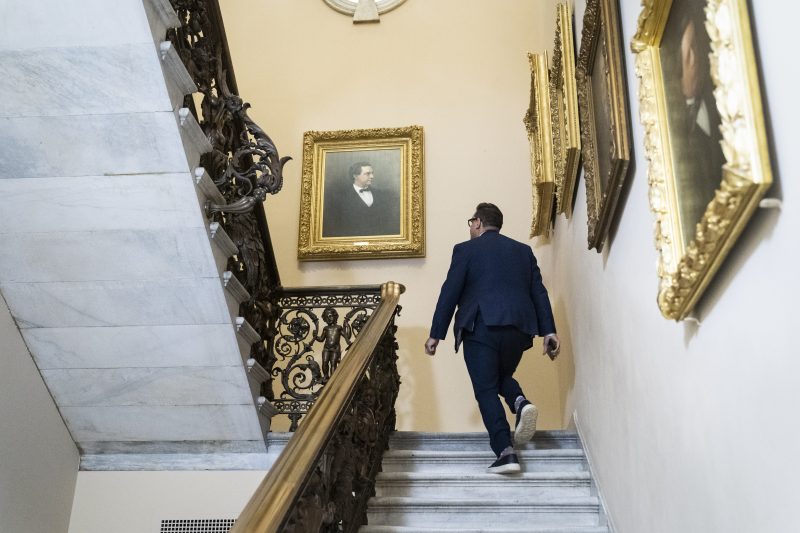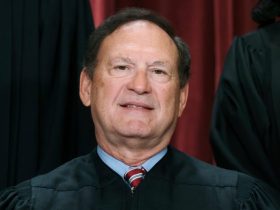If you travel a lot, you are probably familiar with the company Clear. It serves as an identity verification clearinghouse, allowing members to skip or shorten processes such as airport security checks.
Becoming a member of Clear involves paying an annual fee of $189. You can get discounts on that cost and you can shift it up or down depending, for example, on whether you include other members of your family on your account. But there is no obvious mechanism for incurring a charge of $199.99 with Clear.
What about sales tax? you might be asking. And, sure, a fair thing to wonder. The answer is that getting from $189 to $199.99 with the application of sales tax means finding a jurisdiction where the sales tax is 5.815 percent — not 5.81 percent and not 5.82 percent, but 5.815 percent.
In Suffolk County, N.Y., the sales tax is 8.63 percent. I point that out because the person whose incurred cost for Clear landed at exactly $199.99 was Rep. George Santos (R-N.Y.), whose campaign was headquartered in the county. Somehow, on Oct. 18, 2021, the campaign recorded a payment of $199.99 to Clear. And because the payment was $199.99 and not two cents more, the campaign didn’t have to keep an itemized receipt for it.
It was just one of 40 expenses listed by Santos’s campaign (in its most recent, amended filing) that was between $199 and $199.99 dollars — and one of 37 that were precisely that latter amount.
It’s almost like Santos’s campaign was hiding something.
According to Federal Election Commission regulations, “for each single disbursement that exceeds $200, the committee must keep a receipt, invoice or canceled check.” At $200.01, in other words, the FEC could ask the Santos campaign to hand over information about those payments. At $199.99, it can’t. (There was one payment filed that came in at precisely $200, incidentally; it was for a small business that made signs.)
Santos’s $199 disbursements (a shorthand for the 40 payments identified above) fell into three broad categories.
The first was tippable expenses. This included meals, such as the eight meals at the Little Neck, Queens, restaurant Il Bacco. Slate’s Alexander Sammon went there to try to spend exactly $199.99, as all but one of the meals at the restaurant cost. (The visit on Aug. 21, 2021, cost $199.17, oddly.) Sammon’s gambit was foiled, though, by the tip, which pushed him over.
But, of course, the tip is up to the customer, so it’s possible that Santos (or the person on his campaign incurring the cost) was simply in the habit of throwing a nice tip on top of a $160 meal to hit the magic number. (Maybe a math error at that Aug. 21 meal?) There are 31 visits to the restaurant in Santos’s filing, 10 of which actually exceeded $200, so this was apparently not always the practice.
There are other places where the $199 cost might have been deliberately manipulated by the spender. There are five Uber rides, for example, each coming in at $199.99 precisely. Again, you can very carefully choose your tip so it will land at this amount, but that’s a bit tricky, as users of the app will recognize. It’s also a very expensive Uber ride, even in the New York City area.
In total, 16 of the 40 $199 expenditures were ones that might have been a function of tipping.
The second category is hotels. As you are also probably aware, hotel costs can vary depending on how and when you buy them. That Santos’s campaign recorded a $199.99 cost at the Hyatt Orlando in July 2021 isn’t outside the realm of possibility; that particular hotel has rooms at that price range in late July at the moment. That the campaign paid $199.99 at the W Hotel in South Beach, though, is a bit less likely. Prices in October (when the campaign paid its bill) run north of $600.
Can you get a third of a room? Asking for a member of Congress.
The third, and biggest, category of $199 expenses is everything else. This includes disbursements of $199.99 to retailers such as BJ’s Wholesale (twice), Target (once), Walgreens (once), Staples (twice) and Best Buy (three times). It’s possible that there was some recurring cost at Best Buy, for example, for tech support or printer supplies, that sort of thing. But the dates don’t make sense: there was a $199.99 cost on Nov. 10, 2021, and another four days later, for example.
There are also a number of $199.99 payments to airlines, including four to Delta, and two to Amtrak. I perhaps do not need to emphasize this point, but I will anyway: it is not my experience that airline prices in particular are consistent and precise.
One disbursement in October 2021 had the Santos campaign paying $199.99 for parking at John F. Kennedy Airport. A neat trick, given that parking near the Delta terminal at JFK costs $6 for half an hour and $6 for each additional half-hour up to three hours, at which point the cost jumps to $12. There’s also a maximum rate for 24 hours of $70. So, I guess that maybe Santos or someone on his campaign left a car there for two days ($140), three hours ($36), 59 minutes and 58 seconds ($12 for the first half-hour, then $11.99 for the remainder)? This assumes that the garage prorates each half-hour to the second which, again, is not my experience with garages. Nor is it the policy at JFK, which charges for each half-hour “or fraction thereof.” So much for that theory.
What’s odd about the spending is that there’s not much of a rhythm to it. On most of the days that the campaign reported a $199 expense, it reported other expenses, too, often at much larger values. On Dec. 31, 2021, for example, the campaign reported a $199.99 payment to Delta, but also about $239 for food, various payments and transfers to other committees and two Uber trips of under $50. On Nov. 30, 2021, the campaign paid four bills: one to a campaign consultant, another to a credit card company and two trips to Il Bacco.
Given how unlikely it is that so many costs could come out to $199.99 precisely, we might entertain other theories. For example: Perhaps the campaign was covering $199.99 of various bills and then Santos was paying for the rest out of pocket. But, then, those payments would need to be listed as campaign contributions from Santos and the disbursements reported anyway.
Asked about the expenses by the New York Post in December, the Santos campaign indicated that the figures were “the result of a database error and amendments were filed with the FEC.” But it has been more than a month since that comment, during which time amended reports were filed — ones that still include the $199.99. What’s more, if the costs were actually more than $199.99, there should, by law, be receipts documenting the actual cost.
It’s hard to get around the conclusion that the campaign was trying to obfuscate something, a fair assumption given the personal history of the candidate after which it was named. Last month, the suitably skeptical Campaign Legal Center filed a lengthy complaint with the FEC articulating a number of the odd costs above, among other dubious activity. It would probably be advisable for the Santos campaign to quickly put a lawyer on retainer.
If you know of any who cost precisely $199.99, please let him know.








